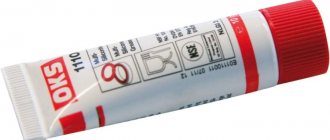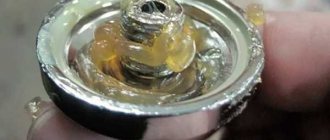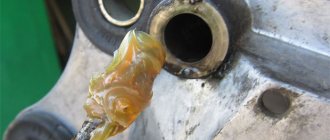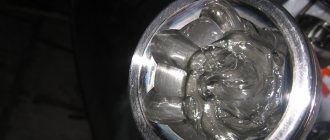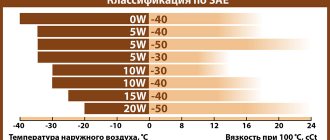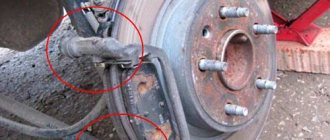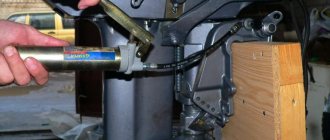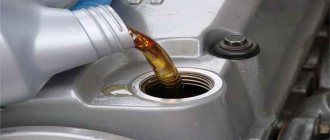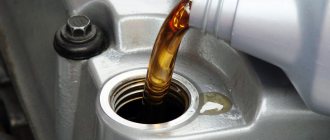Composition of graphite grease
- ordinary graphite powder, which can be used as a solid lubricant;
- soap-based lubricant containing graphite;
- graphite suspension in oil solution (inorganic lubricant).
It is the latter composition that is most often called graphite lubricant and will be discussed further. Its manufacturing technology involves thickening viscous organic or synthetic oil, which is obtained from petroleum products, with calcium soap and graphite powder.
Graphite powder, which is crushed coal, itself has a soft consistency. Therefore, as part of the lubricant, it fills irregularities on the working surfaces of parts, thus reducing friction.
Currently, copper-graphite grease can also be found on sale. Copper powder has been added to its composition. It is able to withstand high temperatures. Typically, copper-graphite lubricant is available in the form of aerosols. Looking ahead, we will say that this composition is often applied to the caliper guides. This will prevent the brake drums and/or discs from sticking to the hub flanges.
Thickening base of graphite grease
Solid oil based graphite lubricant
The most common graphite lubricant is made on the basis of solid oil, this allows it to reduce its cost and maintain its lubricating properties.
The most common graphite lubricant in its usual form is a thick gray grease. But now it is also available in aerosol form, which makes it more convenient to apply it in a thin layer. There is also a copper-graphite spray lubricant on sale, with the addition of copper powder - we’ll talk about using it in a car a little later. Depending on the area of application of the graphite lubricant, you can currently choose a suitable composition - the main difference between the types of such lubricants is the substance that plays the role of an oil thickener, which can be:
- Hydrocarbon.
- Organic.
- Inorganic.
- Soapy.
Making graphite lubricant with your own hands currently makes sense only in terms of satisfying curiosity - commercially available lubricants are inexpensive, and purity and fine grinding of graphite can only be achieved with a fair amount of effort. However, to prepare “graphite” for household needs, it is enough to thoroughly mix the graphite powder with any grease - from lithol to CV joints.
Graphite grease in the standard grease classification
Depending on the composition of the thickener, which is used in the production of plastic lubricants, lubricants are distinguished
- soapy
- inorganic
- organic
- hydrocarbon.
The thickener is the most important element of the lubricant: it forms a colloidal frame, which allows the product, when exposed to significant loads or high temperatures, to change its state of aggregation and be retained in those units where the use of liquid oil is impossible.
The term “graphite lubricant” in the scientific classification refers to an inorganic lubricant thickened with graphite substance, but in utilitarian circles this name is also used to designate lubricants containing graphite as an additive. Thus, it turns out that graphite lubricant is a possible name for:
- Graphite powder as such, used as a solid lubricant;
- Soap lubricant containing graphite;
- Graphite suspension in oil (i.e. inorganic type lubricant).
Soap lubricant with graphite additives is one of the most common lubricants used to protect friction units of heavily loaded mechanisms: springs, agricultural machinery suspensions, gearboxes, bearings, etc. Graphite helps protect metal surfaces from dry friction, prevents overheating of the part and protects against rust.
Properties of graphite grease
Graphite itself is a good conductor of heat and electricity, is not destroyed by moisture, is not affected by static electricity, and is also thermally stable (can withstand high temperatures). The corresponding lubricant also has all these properties, although to a lesser extent.
What is good about graphite lubricant? Its advantages include:
- chemical resistance (when lubricant is applied to working surfaces, its elements do not react chemically with it);
- thermal stability (does not evaporate up to a temperature of 150°C, since the concentration of volatile substances in its composition is minimal, and does not lose its performance characteristics at high temperatures);
- protects work surfaces from moisture;
- has increased colloidal stability;
- explosion-proof;
- has excellent lubricating properties;
- increases wear resistance, mechanical performance and service life of the mechanism where it is used;
- minimizes the number of jams;
- not affected by oil, that is, remains on the surface even if it is present;
- graphite lubricant adheres perfectly to any surface;
- resistant to static electricity;
- has high adhesive and anti-friction properties.
Another important advantage of graphite lubricant is its low price with satisfactory performance characteristics. Although, in fairness, it should be noted that currently there are many other, more advanced lubricants that, although more expensive, have better performance.
However, graphite lubricant also has disadvantages. In particular, it cannot be used in mechanisms with high operating precision, since solid impurities present in graphite will contribute to increased wear of parts;
DETAILS: What are engine mounts and when do you need to replace engine mounts?
Pros and cons of graphite lubricant
The fusion of the features of solid oil and graphite as lubricants gives graphite lubricant the following properties:
- Temperature range of use: - from -20 to + 70 degrees. For heavily loaded mechanisms, the lower limit can be increased - where friction losses do not significantly reduce the efficiency of the machine.
- The lubricant has good water-repellent properties.
- Perfectly protects parts from corrosion .
Modern lubricant production technologies have made it possible to industrially produce high-temperature graphite lubricants with an expanded temperature range for its use - from -40 to +400 degrees. The disadvantages of “graphite” include the limited use of it in assemblies with high precision manufacturing of parts and high speed of their interaction - solid impurities contained in graphite will contribute to premature wear.
Features of graphite lubricant
In nature, graphite is a shiny black substance. It conducts heat and electricity well, does not corrode, is antistatic and can withstand significant temperatures. All these qualities have made graphite a multifunctional material used in various fields of production.
Graphite grease with a calcium thickener is similar in composition to grease, but is more resistant to temperatures and is an excellent tool for eliminating squeaks and protecting metal.
Graphite molecules have their own structural feature: they bind well to metal oxides, but are weakly attracted to each other. This provides high load-bearing capacity of the film and protection against frictional friction.
Characteristics
Externally, graphite lubricant resembles a thick cream of brown or dark color. The characteristics of different types of lubricant differ, primarily regarding the minimum temperature at which it begins to freeze. In most cases this occurs at minus 20 degrees Celsius.
There is another threshold - the maximum positive temperature, which is on average 70 degrees.
It is necessary to pay attention to the fact that graphite lubricant has good contact only with metals that are susceptible to oxidation. In some cases it can be used for processing precious metals. This use is atypical and will not bring the desired result.
If we consider the interaction of a substance with metals in a car, then in this case a reduction in friction is achieved due to the presence of water molecules between the individual layers of graphite. The weak connection of the elements reduces the friction of parts with each other, which is why lubricant has become so widespread in industry.
The current GOST 3333-80, as well as the corresponding technical conditions, indicate the technical and operational characteristics of graphite lubricant.
| Characteristic | Meaning |
| Temperature range of application | from -20°С to 60°С (however, it is allowed to use lubricant at temperatures below -20°С in springs and similar devices) |
| Density, g/cm³ | 1,4…1,73 |
| Dropping point | not lower than 77°С |
| Penetration at 25°C with stirring (60 double strokes) | not less than 250 mm/10 |
| Colloidal stability, % of released oil | no more than 5 |
| Mass fraction of water | no more than 3% |
| Shear strength at 50°C | not less than 100 Pa (1.0 gf/cm²) |
| Viscosity at 0°C at an average strain rate gradient of 10 1/s | no more than 100 Pa•s |
| Tensile strength at 20°C, kg/cm² | |
| tensile | 120 |
| for compression | 270…600 |
| Electrical resistance | 5030 ohm•cm |
| Temperature, °C | |
| decomposition | 3290 |
| maximum permissible operating | 540 |
| average permissible operational | 425 |
| Lubricant oxidation products | CO, CO2 |
| NLGI class | 2 |
| Designation according to GOST 23258 | Ska 2/7-g2 |
When working with lubricant, you must remember and follow the rules below for the safe use of graphite lubricant.
When working with lubricant, observe the following safety and fire safety rules:
- Graphite grease is explosion-proof, its flash point is 210°C.
- If a spill occurs on the surface, the lubricant should be collected in a container, the spill area should be wiped dry with a rag, which should then be placed in a separate, preferably metal, box.
- In the event of a fire, the main fire extinguishing agents are used: finely sprayed water, chemical, air-chemical foam, high-expansion foam and appropriate powder compositions.
The guaranteed shelf life of the lubricant is five years from the date of manufacture.
Composition and characteristics of graphite lubricant
Graphite grease (or, as it is also called, graphite) is obtained by adding lithium soap to petroleum oils. Due to this, it is possible to achieve the required lubricant thickness. Graphite lubricant gets its name from the addition of ground graphite to it, but this is not always done.
Due to its composition, graphite lubricant can be used in a temperature range from minus 30 degrees Celsius to plus 120 degrees.
Please note: Graphite lubricant is often used on ball joints. When the car starts after a long period of parking in severe frosts, a knocking noise may be observed in the supports
This is due precisely to the fact that the graphite lubricant has time to “freeze”.
Graphite grease application
Graphite is an anti-friction filler, i.e. a material that can reduce the coefficient of friction of other materials and has increased resistance to wear during prolonged friction. It is these properties of graphite lubricant that make it possible to use it to protect against premature wear of parts of large and small mechanisms.
Scope of application:
- the lubricant remains chemically stable when exposed to high temperatures, which makes it possible to use it to protect components and elements of metal furnaces, heating circuits, hot dies, agricultural, construction and special equipment - the overall service life increases, the indicators of maintaining metal density improve;
- Mechanism parts treated with graphite lubricant are reliably protected from dust, dirt, soil, small debris and plant debris - this material is actively used for treating agricultural equipment suspensions and open gears, extending their service life in difficult operating conditions;
- the ability of the lubricant to block the formation and development of corrosive areas makes it in demand when caring for shut-off valves that are in constant contact with moisture, as well as for gears and low-speed gearboxes;
- the plasticity of graphite lubricant allows you to block the rapid wiping of elements and parts operating in intensive conditions and in closed housings - in conveyor belts and hoisting and transport machines of any type, maintains the integrity of the main beams and chain drives;
- resists electrostatic friction and reduces the risk of short circuits - used in conveyors and indispensable for rolling stock of electric vehicles, for pantograph runners;
- reliable protection of highly loaded components is required in all supporting structures of production wells for oil, gas and produced water production - the risks of downtime due to system failure are minimized.
DETAILS: How to pay a traffic fine with a 50 percent discount?
For the first time, petroleum-based substances were used to treat individual parts of lifting devices. Subsequently, with the development of technology and the emergence of new methods of oil refining, its use became more active. In any car, a significant part of the fuel energy goes to overcome the friction force.
With the use of graphite, friction between the leaf springs is reduced, and the movement of the parking brake cable is also improved. In addition, motorists use the substance to lubricate hinges and improve the operation of the radio. The latter is achieved by lubricating the contact point - thanks to this, it is possible to cut off unnecessary interference and restore the previous level of signal reception.
In the absence of licensed lubricants, substitutes are sometimes used, however, their freezing point is often above 20 degrees, which is not always acceptable. Therefore, not everyone undertakes to make their own lubricants.
One of the important conditions here has always been maintaining the correct proportion of source materials. So, for 500 grams of solid oil there are 100 grams of gear oil and graphite powder. Before mixing, the solid oil must be heated to 50 degrees. Heating is necessary for rapid dissolution of other components in the grease.
The scope of application of graphite lubricant is very wide. In production it is lubricated with:
- special equipment springs;
- low-speed bearings;
- open and closed shafts;
- various gears;
- shut-off valves;
- suspensions in large-sized mechanisms, special equipment;
- drilling rig supports.
Graphite lubricant can also be used as a prophylactic agent. In particular, it can be used to lubricate threaded connections, ordinary and car locks in summer and especially in winter.
- Low speed conveyor bearings
- Shut-off valves
- Suspension of special equipment
- Open gears
- Springs
- Drill bit supports, etc.
The use of graphite lubricant in various fields of industry is associated with its universal properties. Graphite in the grease ensures smooth operation of mechanisms, protection of highly loaded components, and helps grinding in parts.
Graphite lubricant also finds its use in everyday life. It can be used to lubricate bicycle chains, car parking brake cables, and even regular stiff door hinges.
Where is graphite lubricant used?
According to accepted rules, graphite lubricant is more often used in heavily loaded mechanisms. If we talk about a modern car, then most often it is used to lubricate elements of the steering and suspension systems.
Important: If a graphite lubricant contains mechanical components of graphite, it cannot be used to lubricate all kinds of bearings.
Using graphite lubricant in suspension
Graphite lubricant is most often used in suspension. Experts recommend its use to protect against wear of ball joints in which this composition is placed. Due to this, it is possible to reduce the load on the hinge during operation, which leads to a minimal risk of failure and a decrease in its production.
Please note: When restoration work related to the ball joint is performed, the graphite lubricant is preheated and then placed into the mechanism.
Also, graphite lubricant is often used to fill steering rod boots and tips to extend the service life of the mechanism. In many ways, the mileage before replacing these parts depends on how much lubricant was used during their installation, as well as on the quality of the lubricant itself. When the lubricant is depleted, knocking noises begin to appear caused by severe mechanical friction. If the part is used in this mode, it will quickly become unusable.
Please note: Due to the presence of lubricant in the boot, the oil film formed on the parts has the opportunity to be restored, as a result of which the service life directly depends on the lubricant reserves.
It is also recommended to use graphite lubricant during vehicle suspension assembly to lubricate various threaded connections. You can use regular lithium grease, but the graphite version will significantly reduce the chance of corrosion on fasteners. In addition, if you need to remove parts in the future during repairs, this will be much easier if you lubricate them during installation.
Please note: Another important feature of graphite lubricant is that it seriously improves the quality of the joints of mechanisms.
Another suspension element where it is recommended to use graphite lubricant is the support bearings in the struts, which are subject to serious mechanical stress during operation.
Using graphite lubricant in steering
In the steering system, graphite lubricant is most often applied to the steering knuckle bearings. When assembling the element, you need to fill it as tightly as possible with lubricant. In addition, it is also necessary to fill the protective cap with it in order to increase the total volume of the composition. Such actions will maximize the service life of the bearing. Another way to extend the life of parts is to regularly check that there is enough lubricant and add new lubricant if necessary.
Important: It is necessary to use simple graphite lubricant compositions in the bearing, which do not include mechanical elements of graphite.
The steering rack is also lubricated using graphite lubricants. Here the compound is driven into the housing to lubricate the gear itself. Some car manufacturers recommend that drivers monitor the amount of lubricant in the steering rack while operating the car, and add it if necessary.
Other ways to use graphite lubricant in a car
As noted above, to reduce the risk of corrosion, it is recommended to lubricate threaded elements with graphite lubricant. This can be done not only in the suspension, but also in other car systems.
You can also lubricate the battery terminals with graphite lubricant to eliminate the possibility of corrosive processes occurring on them.
( 157 votes, average: 4.46 out of 5)
How to clean spark plugs from carbon deposits at home
Alternator belt whistles: main causes and troubleshooting methods
Related Posts
Graphite as a filler
- for door hinges and other fittings;
- for locks, latches indoors and outdoors;
- for fastening mechanisms;
- for retractable antennas;
- for bicycle chains;
- for threaded connections;
- for ball joints and steering mechanisms, cable drive of the parking brake in vehicles.
In addition, lubricants with graphite are characterized by economical consumption and ease of application, and do not require frequent replenishment. They do not leak or form oil marks.
Due to the popularity of graphite lubricant among auto repairmen, as well as the simplicity of its composition, there are several traditional methods by which you can make this lubricant at home.
You need to take graphite powder, solid oil and machine oil. Their ratio may be different. The basis is liquid oil, to which grease is added, and then graphite (you can use ground pencil lead or worn brushes of an electric motor or current collector).
However, it is necessary to understand that homemade mixtures will not meet the stated GOST, therefore such lubricants will not meet its standards. In addition, the shelf life of homemade graphite lubricants will be significantly lower than the factory one.
DETAILS: Changing the oil in a Ford Focus 1 gearbox
As mentioned above, an improved version of the classic graphite grease is copper-graphite grease. From the name it is clear that copper powder has been added to its composition, which significantly improves its performance properties. Features of the composition of copper-graphite lubricant include:
- ability to work at high temperatures (in this case it is impossible to indicate a clear range, since there are different compositions on the market with different properties, some of them are capable of working at temperatures of about 1000 ° C and above, read the details in the description of the product);
- ability to withstand high mechanical loads (similar to the previous point);
- increased level of adhesion and stickiness;
- complete elimination of corrosion formations on protected surfaces;
- resistance to oil and moisture;
- The lubricant does not contain lead, nickel and sulfur.
Thus, copper-graphite lubricant perfectly protects working surfaces even under extreme operating conditions. Often, threaded connections are treated with this product before connecting them. This makes it possible to unscrew the connection in the future without any problems.
Popular manufacturers
Finally, let’s briefly look at some domestic manufacturers producing graphite lubricant. It’s worth saying right away that their products are largely similar to each other, so it doesn’t really matter what brand of lubricant you buy. Domestic graphite lubricant meets GOST 3333-80, so all products will be approximately the same.
According to old Soviet standards, graphite lubricant had the designation “USsA”.
So, in the post-Soviet space the production of graphite lubricant is carried out by:
- LLC "Colloidal-graphite preparations". This company produces graphite lubricants for production. Provides wholesale deliveries.
- Oil Right. As of autumn 2020, a tube weighing 100 grams costs 30 rubles. The product catalog number is 6047.
- TPK "RadioTechPayka". A 25 gram jar costs 26 rubles, a 100 gram tube costs 65 rubles, and an 800 gram jar costs 260 rubles.
As for foreign manufacturers, their products have a more advanced composition. As a rule, in addition to graphite, the products contain modern additives and elements that improve their performance. In this case, their description does not make sense, firstly, because the choice must be made based on the goal facing the consumer, and secondly, the number of lubricants and manufacturers is simply enormous!
